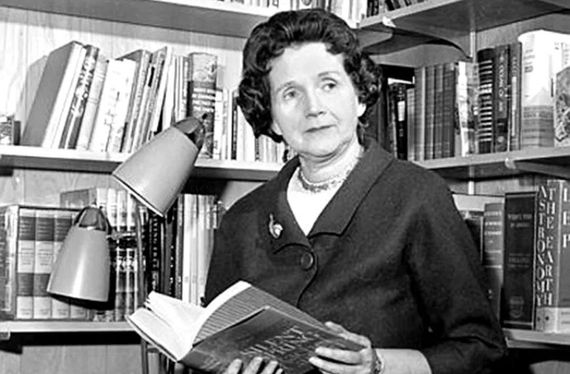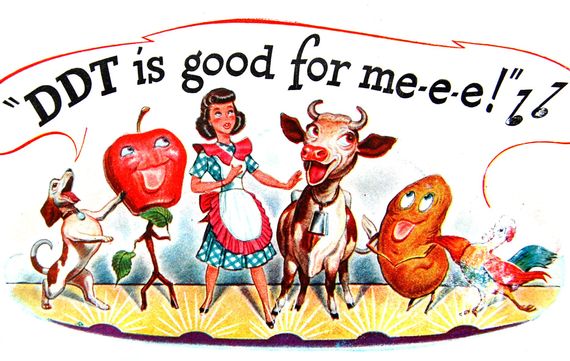It was so safe that it could even be eaten. In a 1946 documentary filmed in Kenya—then a British colony—as part of an anti-malaria campaign by the Kenya Medical Department, an entomologist sprays a bowl of porridge with the insecticide DDT and then spoons it down to show the natives that it is safe to eat. But the Africans appear unconvinced, and rightly so. First used in World War II and then spread and promoted endlessly, DDT was revealed to be a scourge against natural ecosystems by environmental pioneer Rachel Carson, and later discovered to also be harmful to human health. Today DDT is banned in many countries, but it has neither ceased to be used nor has it disappeared. The story of the product that went from miracle chemical to poison is a lesson in the need to vigilantly monitor progress so that it does not end in disaster.
When the Viennese graduate student Othmar Zeidler first synthesised dichlorodiphenyltrichloroethane in his laboratory in 1874, he did not give it the slightest importance; it was just a notation in his notebook, one of the many chemical reactions he was testing for his doctoral thesis. It was not until more than half a century later, in the late 1930s, that the Swiss scientist Paul Hermann Müller, working as a research chemist for the chemical company J. R. Geigy, was looking for insecticides to protect wool from moth attack. The compound previously created by Zeidler, whose name Müller abbreviated as DDT, was lethal to insects, with persistent effects even in very small doses and even after washing the containers.
A “harmless” repellent worthy of a Nobel Prize
When the product, patented by Geigy in Switzerland in 1940, arrived in the US three years later, it caused a sensation. The manufacture and deployment of DDT became a strategic project to protect Allied troops from malaria and other tropical diseases during World War II. It was such a success that, after the war, the use of DDT expanded meteorically, not only as an agricultural pesticide, but also in the consumer market. Advertisements at the time encouraged its use literally everywhere—outdoors and indoors—in every corner of the home, and even on pets. In the mistaken belief that insects transmitted polio, DDT was sprayed on the streets by truck; even children quietly eating their picnic sandwiches were doused with DDT mist sprayed by vehicles.
This abuse of the chemical was based on the idea that DDT was “doomsday for insects,” but completely harmless to other animals and people. Because of the hydrophobic nature of the compound—water-insoluble, fat-soluble—the water-repellent leg ends of insects absorbed the product from crystals deposited on surfaces. The substance attacked their nervous system, paralysing them before killing them. And so, millions of tonnes were manufactured and dispersed without the slightest control or limitation, while in 1948 Müller received the Nobel Prize in Physiology or Medicine for his discovery and was admired and celebrated all over the world.

However, the first alarm bells soon began ringing. As early as 1945, Time magazine, which a year earlier had extolled the virtues of DDT, hinted that the insecticide “may be a two edged sword that harms while it helps.” The reason for such mystery was that the science surrounding DDT, then no longer a military secret, was just beginning to be understood. Until then it was only known that, compared to previous arsenic-based insecticides, there were no known cases of acute poisoning. But army physician James Stevens Simmons, who had also praised the insecticide, wrote that safety tests had been “somewhat alarming.” Those early concerns about DDT’s effects were as much about human health as they were about its effects in nature. And as the media began to report some of this data, manufacturers pushed back, silencing critics with aggressive campaigns.
Rachel Carson and her environmental crusade
The turning point in the history of DDT came at the hands of a woman. In 1962, marine biologist Rachel Carson, who had already achieved success as a nature writer with The Sea Around Us and other works, published Silent Spring. The title alluded to how the indiscriminate use of DDT was silencing birdsong. “Rachel Carson wrote about the early observations that birds exposed to DDT were unable to reproduce because their eggs were failing,” environmental epidemiologist Julia Brody, executive director and senior scientist at the Silent Spring Institute, tells OpenMind.
In a broader sense, the silent spring described by Carson was a grim warning about the environmental harms of the massive use of DDT and other pesticides: Müller’s miracle product is toxic to birds and fish, as well as insects, affecting their behaviour and reproduction, and through these species it passes up the food chain by accumulating in fatty tissues. The book fuelled a debate that turned public opinion against DDT, as well as giving a fundamental boost to the birth of modern environmentalism. Yet Carson has been maligned by both sides: industry has sought to ridicule and discredit her, while organic food advocates who see her as their model forget that, as a scientist, she distanced herself from these movements in favour of using agricultural products that did not create more problems than they solved.

Following the impetus generated by Carson’s work, in 1970 the Environmental Protection Agency was created in the USA, which two years later banned the use of DDT. “Thanks to her work to ban DDT, there are more eagles today in the US than when I was born,” says Brody. Thirty-three other countries subsequently joined the ban, and many others imposed restrictions on its use.
DDT’s collateral and transgenerational damage
DDT’s harmful effects on human health began to be revealed mainly in this century. In addition to being considered an endocrine disruptor, it is included in group 2A—”probably carcinogenic to humans”—according to the International Agency for Research on Cancer (IARC) of the World Health Organisation (WHO). Studies have shown that the risk of breast cancer increases fourfold in women whose mothers were exposed during pregnancy: “the Child Health and Development Studies, a multi-generational study that began with California women who were pregnant in the 1950s and 1960s, provides compelling evidence that DDT increases breast cancer risk as well as affecting other health outcomes,” Brody says. Recent studies have linked DDT exposure to autism disorders, increased obesity and early menstruation in the granddaughters of exposed women, and reduced fertility in women.
These multigenerational effects of DDT may be mediated by epigenetic modifications, which do not cause mutations in the genome, but rather chemical alterations in DNA that can be passed on to offspring. This has been observed for DDT by Michael Skinner, a reproductive biologist at Washington State University specialising in environmental toxicants. “In the rodent model we have demonstrated the ability of DDT exposure to promote the epigenetic transgenerational inheritance of disease for subsequent generations; the main pathologies found were obesity, testis disease, kidney disease and ovarian disease,” Skinner tells OpenMind. In animals, epigenetic marks have been shown to persist for at least four generations, but Skinner suspects they may be permanent, since “in plants, worms and flies, the phenomenon is transmitted hundreds of generations.”

Still, while the manufacture and use of DDT has declined—by around 30% from 2001 to 2014—it is far from being wiped off the map. “Today it is heavily used in India and to a lesser degree in Africa,” says Skinner. It is now being applied for its original purpose, malaria control. It has been an essential tool in the WHO’s global malaria control programme, which in 1971 estimated that DDT had saved more than a billion people from malaria. Today the WHO continues to recommend its use for indoor spraying, and countries such as South Africa use it routinely. There is even talk of growing support for this use of DDT, as it is a cheap and affordable product for which there is still a lack of clear alternatives, although mosquitoes also develop resistance over time.
To make matters worse, DDT qualifies as a persistent organic pollutant. “The long half-life of DDT indicates it will be in our environment for over 500 years, so it is not removed but persists today,” says Skinner. He adds that the insecticide remains a primary contaminant in lake and river sediments in the US, where it was banned half a century ago. And it is still detectable in the blood of part of the population. Since 2004, the Stockholm Convention regulates the use of persistent organic pollutants, but allows DDT to be used for malaria control. Added to this are the stocks of DDT still accumulated in some countries, along with the thousands of barrels of the compound that were once dumped at sea and are still being discovered. “It is far more critical to stop this, for our great grandchildren’s sake in the future,” Skinner concludes.
Comments on this publication